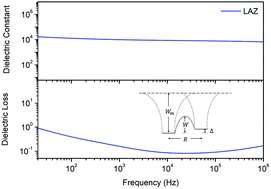Electron-pinned defect dipoles in (Li, Al) co-doped ZnO ceramics with colossal dielectric permittivity†
Abstract
Through systematic optimization studies of Li and Al co-doped ZnO ceramics we demonstrate that colossal permittivity with low dielectric loss (εr = 9862 and tan δ = 0.159 at the frequency of 1 kHz) at room temperature can be achieved in Zn0.99(Li0.1, Al0.2)0.033O. The colossal dielectric constant (CDC) and low dielectric loss in this ceramic have relatively good frequency and temperature stability. Annealing the ceramic at 900 °C in oxygen leads to the drop of εr to 2250 but the dielectric loss remains at ∼0.10. Dielectric spectrum analysis shows that the CDC is associated with two relaxation processes. One of these process vanishes and the other one persists after annealing, suggesting that P1 is associated with oxygen-deficient defects. For samples exhibiting CDC, ac conductivity study revealed correlated barrier hopping between defect states in the band gap. A model involving these defects as the electron pinned defect dipole is proposed. The experimental dielectric data are well described by this model using Kirkwood's theory and Kramer–Krönig transformation.



 Please wait while we load your content...
Please wait while we load your content...